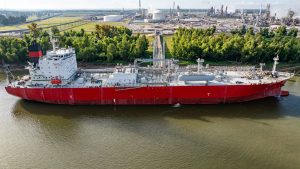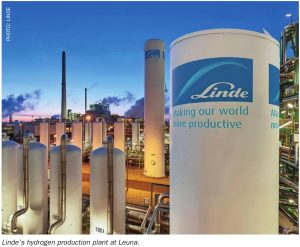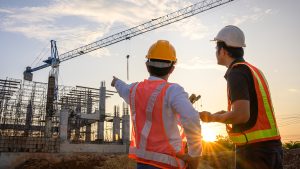
Blue ammonia projects
Blue ammonia – ammonia produced from fossil hydrogen with carbon capture and storage (CCS) – offers a cheaper alternative than green ammonia for low carbon supply in the short term, and is more suited to retrofits.

Blue ammonia – ammonia produced from fossil hydrogen with carbon capture and storage (CCS) – offers a cheaper alternative than green ammonia for low carbon supply in the short term, and is more suited to retrofits.

ClassNK has added Japan's first hydrogen-fuelled tug Ten-Oh to its register, built by Tsuneishi Shipbuilding Co., Ltd. This vessel was developed and built under the 'Nippon Foundation Zero Emission Ships Project', a grant program by The Nippon Foundation aimed at developing ships with zero CO2 emissions. Based on discussions among the parties involved during the planning stage of the vessel, ClassNK reviewed the safety requirements and countermeasures for hydrogen-fuelled ships by applying Part GF of its 'Rules and Guidance for the Survey and Construction of Steel Ships' etc. These reviews focused on issues such as preventing explosions caused by the high ignitability of hydrogen and mitigating the potential impacts of hydrogen fuel leakage on crew members and the environment.

Clariant has signed a strategic cooperation agreement with Shanghai Boiler Works, a full subsidiary of Shanghai Electric specialising in energy conversion and the development of new energy applications, to jointly foster innovation in sustainable energy solutions. The partners will combine their expertise to advance green energy projects in China. The agreement is the result of close and successful cooperation in Shanghai Electric’s new biomass-to-green methanol plant in Taonan, Jilin Province, China. In addition to supplying its MegaMax catalysts, Clariant provided technical on-site support during the successful startup of the 50,000 t/a plant. The second phase of the project, with a capacity of 200,000 t/a green methanol and 10,000 t/a of sustainable aviation fuels (SAF), is expected to start production in 2027. The ceremony for the official signing of the partnership contract took place last week at the Clariant Innovation Center in Frankfurt, Germany.

thyssenkrupp Uhde has completed the pre-FEED (Front-End Engineering Design) phase for the Portland Renewable Fuels Project in collaboration with HAMR Energy. The project, located in Victoria, Australia, will use biomass residues and renewable electricity to produce green methanol that can be used as a low carbon liquid fuel to power shipping and aviation.

The Deendayal Port Authority (DPA), Kandla, has issued a tender for the engineering, procurement and construction (EPC) contract to build India’s first port-based bio-methanol plant. The 3,500 t/a plant will use oxy-steam gasification technology to convert biomass into bio-methanol. The scope covers design, engineering, procurement, construction, commissioning, and product certification, with bidders required to outline plant life, warranties, capital expenditure, and operating costs. The move follows DPA’s earlier call in May for turnkey proposals for a larger integrated plant of over 15,000 t/a, and its February 2025 agreement with Bapu’s Shipping Jamnagar Pvt. Ltd. to develop India’s first bio-methanol bunkering facility, including a dedicated bunker barge, at Kandla Port.

Chinese electrolyser manufacturer LONGi Green Energy has begun construction on a $325 million green methanol project in Inner Mongolia that will combine biomass gasification with hydrogen from the company’s electrolysers. The project, being developed at the Urad Rear Banner Industrial Park, will process 600,000 t/a of agricultural waste to produce 190,000 t/a of green methanol in the first phase. Phase 2 will expand ethanol capacity to 400,000 t/a, with hydrogen coming from new electrolysers powered by 850 MW of wind and 200 MW of solar power. LONGi says that the project will cut carbon dioxide emissions by 1.2 million t/a, while adding more than 1 GW of wind and solar capacity to the region’s energy mix.

Polish company Hynfra PSA and the New & Renewable Energy Development Corporation of Andhra Pradesh have signed a memorandum of understanding to create the joint venture company JK Srivastava Hynfra (JKSH). The company plans invest $4 billion to build a new green ammonia plant powered by up to 3 GW of solar and wind energy supported by battery storage at Visakhapatnam in India’s Andhra Pradesh province. The plant will initially produce 100,000 t/a of green ammonia, with the eventual goal of scaling up to 1 million t/a. The first phase is due to be completed in Q1 2029. Some of the green ammonia will be exported to Japan, South Korea and Taiwan, while the remainder will be used domestically in the fertiliser and power sectors, particularly to support the decarbonisation of coal-based power generation through ammonia co-firing.

Three European energy companies are planning to develop a green methanol plant in Spain that will capture around 380,000 t/a of biogenic carbon dioxide, which will be used to produce 200,000 t/a of methanol. Spanish renewable energy firm Magnon will oversee the carbon capture portion of the project, while partners Power2X and ErasmoPower2X will handle […]

UK engineering and consulting company Wood has received a contract from the UAE’s chemicals and transition fuels hub TA’ZIZ to provide project management consultancy for the development of one of the largest methanol plants in the world. Wood will work with TA’ZIZ’s engineering, procurement and construction (EPC) contractor, Samsung E&A, to deliver this project. Gerry […]

I am writing this freshly returned from the Sulphur Institute’s annual Sulphur World Symposium in Florence (for more on that see pages 24-25), where one of the topics causing some excitement was the anticipated commissioning of a demonstration plant for Travertine Technologies’ new Travertine Process. The plant is due to be commissioned at the Sabin Metals site near Rochester, New York in mid-2025 at a cost of $10.7 million. Capacity is put at “hundreds” of tonnes per year of gypsum processed, and removing “tens” of tonnes per year of CO 2 from the atmosphere.